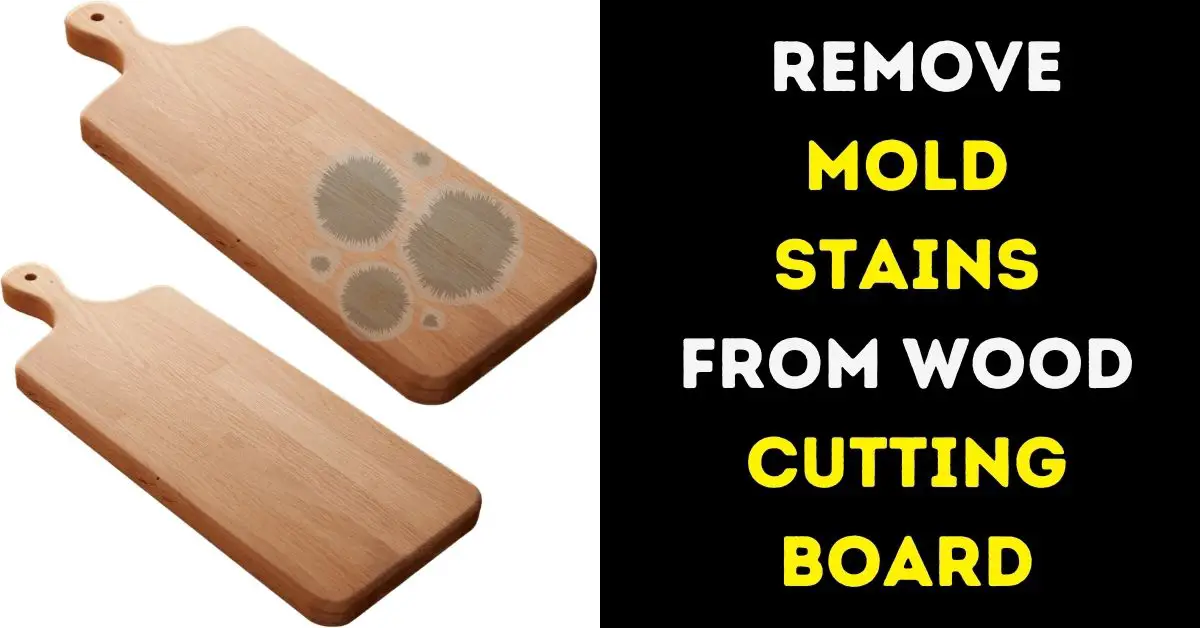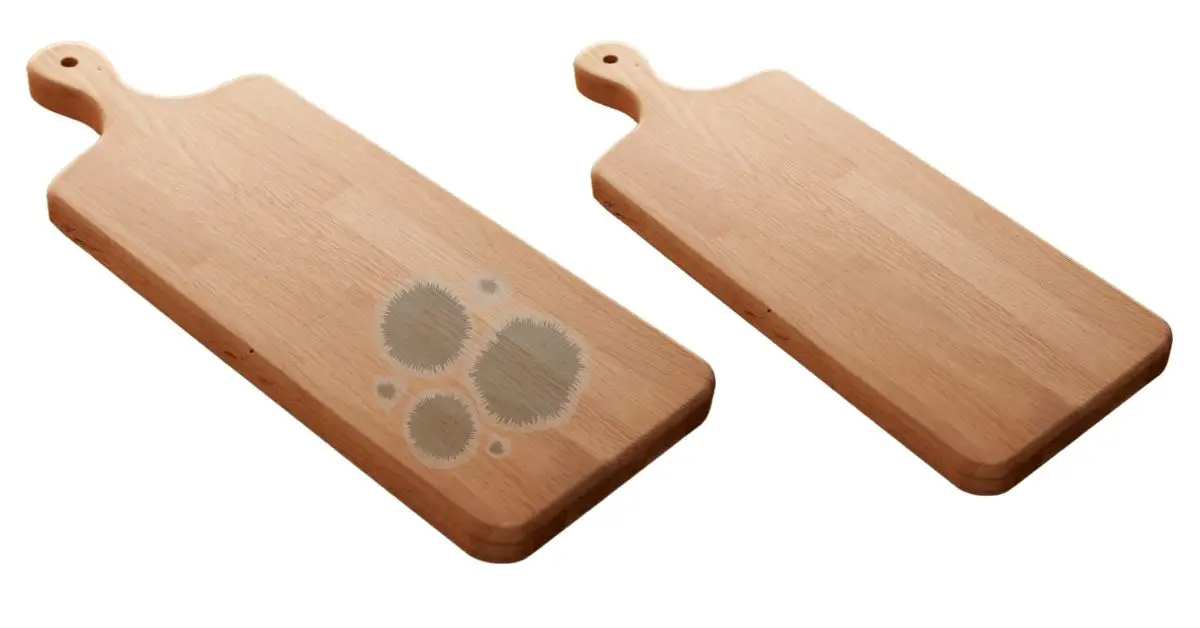
A clean and sanitary cutting board is an essential tool in any kitchen, ensuring the safety of your food and your health. Wood cutting boards, while favored by many for their durability and aesthetics, are prone to a common issue: mold stains.
Mold can thrive in the moist and porous surface of wood, making it crucial to know how to effectively remove these stains and maintain a hygienic food preparation environment.
In this post, we will walk you through the step-by-step process of removing mold stains from your wood cutting board.
How to Remove Mold Stains from Wood Cutting Board

Materials Needed
Before I dive into the step-by-step cleaning process, it’s essential to gather the necessary materials and items. Here’s a list of what you’ll need to effectively remove mold stains from your wood-cutting board:
- Vinegar: This natural ingredient will serve as a key component in our cleaning solution.
- Baking soda: Known for its cleaning and deodorizing properties, baking soda will help combat mold stains.
- Lemon: Lemon’s acidity will act as a powerful natural cleaner.
- Salt: Salt will be used in combination with lemon to create a scrubbing mixture.
- Scrub brush: A scrub brush with gentle bristles will aid in removing mold stains without damaging the wood.
- Cloth or paper towels: These will come in handy for wiping down and drying the cutting board after cleaning.
Now that you’ve gathered your materials, let’s proceed with the step-by-step cleaning process to revive your wood cutting board.
Step-by-Step Cleaning Process
Step 1: Inspection Begin by closely examining your wood cutting board for any mold stains. Take note of the affected areas, as these will be the focus of your cleaning efforts.
Step 2: Preparing the Cleaning Solution To create a natural and effective cleaning solution, mix vinegar, baking soda, and water. This combination harnesses the cleaning power of vinegar and baking soda while diluting the vinegar’s acidity for safe use. Remember to take safety precautions when handling vinegar, as its odor can be strong.
Step 3: Applying the Cleaning Solution Now, it’s time to apply the cleaning solution to the mold stains. Using a cloth or sponge, gently apply the solution to the affected areas. Allow it to sit for a few minutes to break down the mold.
Step 4: Lemon and Salt Scrub For stubborn mold stains, you can create a lemon and salt scrub. Squeeze lemon juice onto the stains and sprinkle salt over them. Then, use a scrub brush to gently but effectively scrub away the stains. The lemon’s acidity and salt’s abrasiveness will help remove the mold.
Step 5: Rinsing and Drying After you’ve successfully removed the mold stains, it’s crucial to rinse the cutting board thoroughly with water. Ensure that no cleaning solution or residue remains. Once rinsed, pat the board dry with a clean cloth or paper towels.
By following these steps and using the listed materials, you’ll be able to restore your wood cutting board to a clean and mold-free state, ensuring both its longevity and the safety of your food preparation.
How To Prevent Mold Growth From Your Cutting Board
Preventing mold growth on your wood cutting board is essential to ensure food safety and prolong the life of your cutting board. Here are some effective tips to prevent mold from developing on your wood-cutting board:
1. Regular Cleaning
After each use, wash your wood cutting board with hot, soapy water. Use a brush or sponge to thoroughly clean the surface, including any grooves or crevices where food particles can accumulate. Rinse the board with clean water and dry it promptly with a clean cloth or paper towel.
2. Sanitizing
To further reduce the risk of mold and bacteria, occasionally sanitize your cutting board. You can do this by wiping the board with a mixture of one part white vinegar to four parts water or by using a diluted bleach solution (1 tablespoon of bleach per gallon of water). After sanitizing, rinse and dry the board thoroughly.
3. Avoid Immersing in Water
Never submerge your wood-cutting board in water or leave it soaking for extended periods. Excessive moisture can cause the wood to swell, crack, or warp, making it more susceptible to mold growth. Instead, clean it quickly with a damp cloth and dry it thoroughly.
4. Use Food-Grade Oils
Periodically apply food-grade mineral oil or cutting board oil to your wood cutting board. This helps maintain the wood’s moisture balance and creates a protective barrier that inhibits mold growth. Follow the manufacturer’s instructions for application.
5. Store Properly
Store your cutting board in a dry and well-ventilated area when it’s not in use. Avoid storing it in a damp or humid environment, such as under the sink or in a dark, closed cabinet, as this can promote mold growth. Store it upright or on its edge to allow air circulation.
6. Regularly Inspect for Damage
Check your cutting board regularly for signs of damage, such as cracks, deep grooves, or splinters. These areas can trap moisture and food particles, providing a conducive environment for mold growth. If you notice any damage, consider repairing or replacing the board.
7. Avoid Cross-Contamination
Use separate cutting boards for different food groups, such as one for raw meat and another for fruits and vegetables. This practice reduces the risk of cross-contamination and the spread of harmful bacteria, which can contribute to mold growth.
8. Dry Thoroughly After Cleaning
After washing your cutting board, ensure it’s completely dry before storing it. Moisture left on the surface can create a breeding ground for mold. Use a clean cloth or paper towels to pat it dry, or stand it upright to air dry.
9. Limit the Use of Harsh Cleaners
Avoid using harsh or abrasive cleaning products that can damage the wood’s surface and make it more susceptible to mold. Stick to mild dish soap and warm water for routine cleaning.
10. Rotate Cutting Sides
If your cutting board has two usable sides, periodically switch sides to distribute wear and tear evenly. This can help extend the life of your cutting board and reduce the likelihood of mold forming in heavily used areas.
Conclusion
Tackling mold stains on your wood cutting board doesn’t have to be a daunting task. With the right materials and a little effort, you can restore your cutting board to a clean and safe condition for food preparation. Remember that a clean cutting board is essential for maintaining good kitchen hygiene and ensuring the health and safety of your loved ones.
You can effectively remove mold stains from your wood cutting board and prevent their return by following these steps.
Maintaining a mold-free cutting board is just one aspect of responsible food preparation, but it’s an important one. So, take the time to care for your cutting board, and your kitchen will be a healthier and more enjoyable place to cook.
